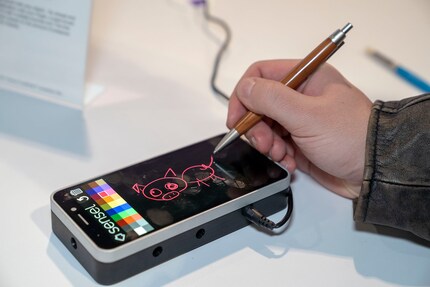The successor to the folding screen presented at the CES?
Pressure Grid should one day replace the current touchscreen technologies. At least that is the hope of the company that developed the flexible screen, which works under water and without an electrical charge on the interaction object.
The FlexPai, the first foldable smartphone, will be presented at the stand of the Chinese brand Royole. The FlexPai's screen behaves like that of a non-foldable phone. This is not good enough for the start-up Sensel, just a few metres away from Royole and not at all affiliated with the major Chinese manufacturer. They have the successor to the smartphone screen commonly used today at their stand.
Or a proposal on how foldable smartphones could work in the future. Or the touchscreen in general.
The problem with the touchscreen
Two technologies are currently being used in our world that essentially pass for touchscreens. The industry is constantly researching other variants and technologies, but the majority of touchscreens can be explained by these two methods.

- Capacitive: The touchscreen reacts to anything that contains an electrical charge. Stylus pens or human fingers, because we humans generally have a negative electrical charge. Your smartphone and tablet have such a screen.
- Resistive: The touchscreen reacts to pressure. These are the parts in the post where you have to sign. Or the touchscreens on some cash machines. However, the technology is useless for smartphones, as you always have to press firmly on the device. That's annoying.
Both technologies have their advantages. Graphics tablets rely on resistive elements that allow several thousand pressure points and thus define the thickness of a virtual brushstroke. Capacitive surfaces allow fast and error-free interaction with a device. But capacitive technology is tricky. If the screen is wet, too warm, too cold or anything else, the system will go haywire.
The young company Sensel from the USA has developed a new screen technology that combines the advantages of both technologies and is also compatible with the latest developments. The whole thing is called Pressure Grid and could revolutionise the world of smartphones.
Sensel has blocks on the table
The prototypes of the new Pressure Grid screen technology are vaguely smartphone-like. The devices run Android, version irrelevant. The important thing is the app that is on the screen for drawing. If you brush on it with your finger, it works well and easily. Pressure levels are also possible, but the Samsung Note 9 can already do that with the pen. In this respect, it's not really spectacular yet.
The next table, where a prototype is submerged in a basin full of water, is exciting. Here, a capacitive display would possibly, very probably, fail. The Sensels technology continues to work, just as it does in the air.
I can scribble on the display with my biros from my trouser pocket, with brushes provided and with the Sennheiser MD46 bone microphone. It all works. The technology is also bendable, so it can be installed in any foldable or two-sided smartphone.
A screen with Pressure Grid is similar in structure to a normal touchscreen. It can be explained in four layers. From bottom to top, these layers are:
- Gadgets and tangled cables
- Pressure Grid Sensor Array
- Flexible display
- Protective glass over the display, also flexible
The three layers above the tangle of cables are about one millimetre thick. The sensors on the array are installed one millimetre apart and have 16 contact points that measure the force of the pressure. The display has a resolution of 6500 dpi and the frame rate can vary from 250 Hz to 1000 Hz.
Sensel is hoping to sell the technology at CES and find a major customer interested in the start-up's display.
All articles on CES 2019 can be found here.
Journalist. Author. Hacker. A storyteller searching for boundaries, secrets and taboos – putting the world to paper. Not because I can but because I can’t not.
From the latest iPhone to the return of 80s fashion. The editorial team will help you make sense of it all.
Show all